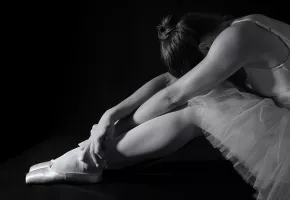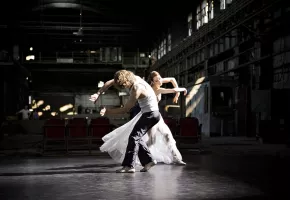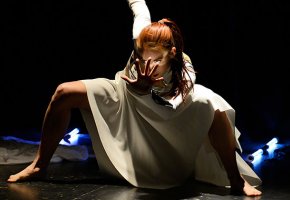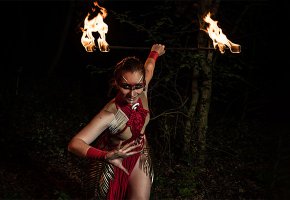Monika Vaverová and her take on fire show and light show costumes
Monika Vaverová is the founder of the successful costume studio MIMOspace. Her costumes appear not only on stages all over the world, but can also be seen in films, TV shows or even in the sports industry. In this article I give you important information about creating costumes not only to be effective, but mainly functional.
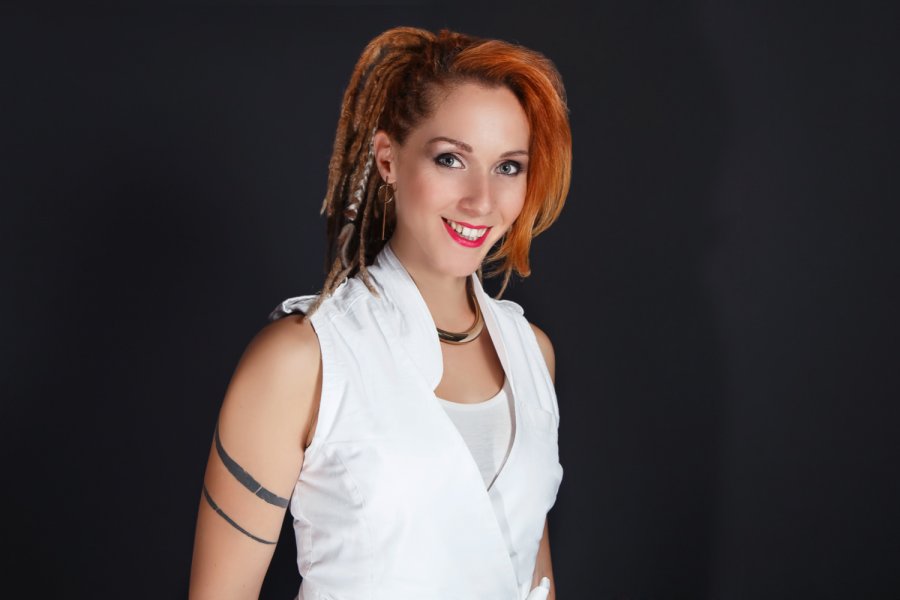
A successful designer and also an experienced fireshow performer. When you add a tremendous amount of creativity and the courage to explore uncharted ways to that combination, the results are breathtaking. I dare to say that Monika is the guru of fire show and light show costumes. And there really is no better designer in the Czech republic who understands both disciplines and who can create inventive costumes in hundreds of different ways. (And I’m not exaggerating, over 500 costume designs have been created in MIMO space Atelier). In the interview, Monika revealed how she approaches creating performance costumes and her creative process. :)
How do you think and proceed when creating a costume for performers?
Although it may not seem like it, creating a costume is an extremely complex matter. It takes a lot of input information to create an original costume that also emphasizes the idea of the show. Each group has a different energy and I try to capture and express their character.
Before I start creating the first designs, I need to have a basic package of information from the artist. This means the overall character of the group, the concept of the particular show, and what feeling should remain in a spectator. Then the technical aspects such as music, lighting conditions, choreography, movement difficulty and in what situations the costume should work in.
It's also very much about individual requirements. Some people need the costume to be fully subservient to function, fit perfectly on the body, be quick to put on or withstand extreme treatment.
Others, on the other hand, will prefer a pompous look even at the cost of less mobility or comfort. For example, if the main element of the performance is comical, and the fire show, light show or juggling are just an additional activity, they may not mind any crazy costume cut or oversized elements. Like a giant skirt - it might be harder to dance in, but the performer can use it to enhance the atmosphere of the show.
Therefore, there is no such thing as a universal costume. Just a fire show is an incredibly vast field. For example, jugglers, fakirs, historical fencing, belly dancing with fire, dance performances, new circus, modern technical fire show performances - and each has its own unique characteristics.
Once we have a clear concept and requirements, it's time to create a mood board with inspiration and a color scheme. Finally, we get down to choosing materials and cuts.
Terezka: “I really liked the process when we sat down with Monika and started talking about various ideas, brainstorming. She drew some beautiful designs in a matter of moments and actually led me to an incredibly complex A+ show. And thanks to the fact that I was able to watch her through the process, my thinking about creating a show has changed a lot. Working with Monča is just crazily inspiring."
Classics versus innovation
Good old classics or would you rather venture into uncharted waters?
Innovation is becoming a trend. Innovating is challenging. To have a good effect, you need to invest a lot of time and money. And that risk doesn't always have to work out.
I see three categories in the market of fire show performer groups. The first one is groups that specialize in the luxury full-time league and can afford to do things differently, sell something unusual and maybe set a trend.
Next to that are groups that have fire show and light show as a hobby. These are more likely to go the way of tried and proven styles. And finally we have small, local groups. They can do pretty much anything, because their clientele probably won't know or expect trends. That's why I try to appeal to groups to think about who their target audience is or where they see themselves compared to other groups.
What about color combinations? Is it a good idea to stray from the proven classics, or rather try to work on a trendy style in a new way?
The color clichés are there for a simple reason - they work. They create some expectations and at the same time give the client a certain guarantee. When you say fire show, most people outside the community think of black and red. If a group wants to differentiate themselves, they have to prepare the client in advance and let them know exactly what they're getting into to avoid any potential disappointment. So the repertoire should always include a basic show. If they want to create something unique, then come up with an extra themed show where we can go off the beaten track.
One costume for multiple performers?
"Practicality versus aesthetics."
Do you think it's better to do customized costumes or one-size-fits-all?
In large groups, universal costumes are incredibly practical and awesome. I think it depends a lot on how professional the group’s approach to performing is. If it’s their full-time job, every performer should have their own tailored outfit. If I'm selling a high-end show, the customer has certain expectations, and if they see that costumes have been skimped on, it doesn't add much to the reputation.
For other categories of groups, on the other hand, one-size-fits-all costumes make sense. They usually have lower budgets and they can change performers more often. In that case, I recommend thinking about the sizes the costumes will be made for, and the distance from the audience so that any imperfections in the outfit would disappear. The most common problems are the lengths in general - trousers, sleeves.
For universal costumes, it is good to consider several things. I think it's ideal to make a size-variable element a part of the costume so that it's visible and acknowledged, but aesthetic. I'm not a big fan of Velcro, but lace-ups can be efficient and also effective. At the same time, you need to think about material and fit in a complex way. Everybody has a different shape, and the basic cut needs to be adjusted accordingly. Flexible materials that can compensate for any differences can help a lot.
To burn or not to burn? Costume and fire
"Burn! I mean... At least on the combustion test, definitely. The best way to find out if your fabric is suitable for a fire show costume is to set it on fire.
What's the most important aspect of designing a fire show costume for you?
For me, safety is definitely first, followed by functionality, although it can sometimes be a little bit at the expense of the visual. If I need to incorporate a large element, I use snaps and Velcro so it can be removed quickly if needed. And, of course, the visuals should correspond with the show so that everything works together.
What are the least flammable materials for fire show costumes?
The best is obviously leather, because it doesn't burn and it lasts. Followed by natural materials, 100% cotton with a strong weave, ideally twill. The higher the weight, usually the better. I use strong leatherette very often. I don't recommend synthetic materials, they often burn and melt, but it’s true that nowadays, there are many exceptions. There are plenty of mixed materials that have very good properties. So don't be afraid to test the fabric sample under a flame first.
How do you proceed when choosing a material?
I don't really follow the description of the material on the label. It happened to me many times that the stated composition was visibly not the one of the fabric, or due to the number of sellers, the real composition is merged into a few % and you don't know anything, they just write 100% polyester. Synthetics may not be a bad choice. I definitely always do a burning test first. I light a corner of the fabric on fire and compare how fast it burns, if it just turns black or if it melts. And then I follow the designs.
Functional flexible materials combined with fire? Do they work together?
It's certainly not an obstacle, but you have to be careful where you sew it in. Because in addition to safety, the materials also affect the durability of the costume. If you put lycra on the breasts, it's clear that after the first show with pyrotechnics, you'll probably see burn holes in the costume. If you have to use an easier-to-burn material, I recommend putting it on the hips or back.
Creating a costume for a light show
"LED costume? It's a challenge, but it's doable. Light up your bones. "
We have multiple categories of light shows from UV shows to LED and laser shows, video mapping shows to LED costume-based shows. Lights can be beautiful to play with, but they can also do harm to the overall visual.
What to look out for with UV costumes?
The first key to success is, of course, to have a UV active fabric. :) It may come as a surprise, but for example, white doesn't automatically mean it'll glow under UV. Therefore, when choosing materials, it is a good idea to take a pocket UV light with you.
For the costume itself, I recommend focusing on the often neglected parts like the face, hair and limbs. Without them, the dance choreography is easily lost and the performer looks like a levitating white blob. You can play beautifully with masks or UV paint on the skin, which nicely supports the idea you want to express in the show.
LED costume - How to make it aesthetic and functional?
Having an LED costume in your repertoire is definitely a big leap up and they definitely get the attention of clients. However, it's a double-edged sword. Unless the costume is thoroughly thought out and incorporated to the whole show, it can end up doing harm. It's like buying an expensive sports car - either I have a lot of money and time to take care of it, or it's better not to get it at all. I would definitely avoid the approach "I'll put Christmas lights on and I'm good". So, again, I go back to the beginning, and that is to have a coherent vision for the show.
What are the most important aspects you consider when designing an LED costume?
An LED costume is a big struggle between practicality and aesthetics. Not only is it challenging to produce, but it also requires a lot of of technical maintenance. So as a designer, I have to come up with not only a strong visual, but also where to lead wiring, where the power supply(s) will be located, detachable parts, washability, mobility, etc. etc. All this also has to take into account mechanical wearing and be accessible for replacement. Generally bending is not good for LEDs. I follow the rule that when there is a solid bone, there can be light.
Terezka's words in conclusion
Costume design is an incredibly complex and challenging field. It's not hard to dress people for a show in a sufficient way, it's hard to support the show with a costume, to complement it, to elevate the costume to be functional, practical and aesthetical at the same time.
For Aliatrix, Monika's MIMO Space atelier has created multiple costumes and each time it has been an incredibly enjoyable and rewarding collaboration. Whether we came to Monika with a specific design or just a vague idea for a "cool costume" with no clear specifications of what it should look like. Each time Monča managed to magically create a breathtaking piece of work that surprised us in many ways.
For me, the opportunity to watch Monika at work is incredibly inspiring and I am incredibly grateful that she agreed to an interview and revealed her know-how to you.
If you enjoyed the article and don't want to miss other interesting facts from the world of show business, subscribe and follow us on Facebook and Instagram.
We would like to pass on what we have learned thanks to others. Everything we publish is done with humility, respect and a desire to give back to the world what we ourselves have received.
We will be happy if you share it and let us know your opinion. How do you approach costumes?
Have a great time and thank you for your support and willingness to learn together.
About the author

Tereza Adamusová
She has been on the artistic scene since 2010. She has taught juggling and performed with the group T.E.T.R.I.S. As a performer, she has been in several major productions and has performed in hundreds of shows around the world. Since childhood, she has been doing gymnastics and acrobatic synchronized swimming. As a dancer and actress she has performed in Czech musicals. She co-owns the Aliatrix agency and as creative director, she is also the main producer of all major projects.






